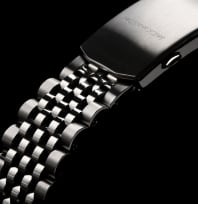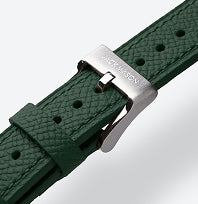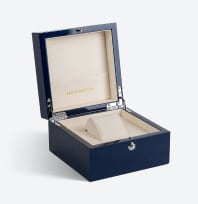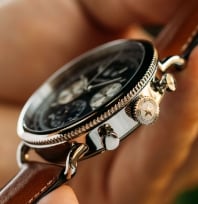Your Go-To Guide For Understanding Quartz Watches
When you’re looking for the best possible watch to wear to match your lifestyle and style preferences, quartz watches are definitely worth knowing about. In this article, we will cover the key differences between quartz-powered watches and other types of watch movement. In addition, you will learn how to distinguish different types of quartz watches from each other, as well as when the best time is to wear each type of watch.
Having a comprehensive knowledge of how quartz watches work will make the process of choosing the best watch for you much more enjoyable, and it may even leave you with a new and rewarding hobby.
What Is Watch Movement?
Not all watches are built the same. Sometimes, the distinctions between one watch and another are more obvious, such as the presence of complications on a watch’s face or a different type of strap. These differences can affect the functionality of a watch, but there is more going on under the surface that also makes one watch different from another.
One of the primary distinctions between different watches is the various types of watch movement. A watch movement is the mechanism that keeps the watch ticking and reading accurately. The primary types of analog watch movements are mechanical, automatic, and quartz.
It is important to note that there is a difference between a watch’s type and its movement. You can wear a quartz watch of various styles, for example, such as a quartz dive watch or quartz aviation watch. Likewise, you can wear a mechanical dive watch or mechanical aviation watch.
The watch’s type, usually easily distinguishable by its appearance and features, is independent of its movement.
These two categories are some of the most important characteristics of a watch that you will need to know before buying it.
Mechanical Movement
Mechanical watch movement is the oldest means of making a watch work. If you have ever seen a photograph of the inner workings of a wristwatch, filled with interconnected cogs and gears, you are likely looking at the interior of a mechanical watch.
These watches are revered by many for the intricacies of their design. A mechanical watch needs to be manually wound periodically to keep ticking, whereas automatic watches only need winding if they go unworn for long periods of time, and quartz watches require no manual winding.
Many consider watchmaking to be an art form, and, looking at the intricacies of the mechanisms that power a mechanical watch, it is easy to see why. However, the amount of effort and craftsmanship required to assemble a mechanical watch makes watches powered by mechanical movement luxury items in most cases.
Generally speaking, a mechanical watch will not function more reliably than a quartz watch, and may even require more upkeep and maintenance due to the necessity of manual winding. However, many appreciate mechanical watches simply for the artfulness of their design. Ultimately, the high price point for mechanical watches has much more to do with their status as collectibles and pieces of art rather than being due to higher functionality.
Automatic Movement
Automatic watches require less hands-on upkeep than mechanical watches but still need to be wound occasionally if they are not worn regularly.
A mechanical watch is indirectly powered by the movements of the wearer’s wrist, which causes a weighted rotor within the watch to spin, storing energy in the watch’s mainspring. This stored energy allows the watch to continue ticking accurately with minimal interference from the wearer, as long as the watch is worn consistently to provide energy to the mainspring.
Automatic watches are not as high-maintenance as mechanical watches, but they still require more from the wearer than their quartz counterparts. In addition, an automatic watch contains a weight as part of its rotor mechanism. This means that an automatic watch will typically be heavier than a quartz or mechanical one. The weight of an automatic watch is a selling point for some and a major drawback for others.
Quartz Movement
A more recent invention in the scheme of watchmaking history, quartz movement is a testament to human ingenuity. Quartz watches are powered by a battery that sends a current through a piece of quartz inside the watch, creating vibrations. These vibrations are precisely calibrated to make the hands of the watch tick at the necessary rate per second to keep the watch working properly.
The presence of battery power in a quartz watch means the wearer never needs to wind the watch to keep it ticking. Quartz watches are famously low-maintenance and have far fewer intricate components inside of them that might break down and take time and money to repair.
Quartz movement has become something of a standard for analog wristwatches in recent decades since its invention in 1969. The technology is convenient, durable, and simple, making it ideal for daily wear.
Why Wear A Quartz Watch?
Because of the low-maintenance design of a quartz watch, it is a perfect movement to power the watch you wear every day. Mechanical watches can feel too fragile to wear frequently and often end up becoming more artifacts than well-loved, useful accessories.
Likewise, an automatic watch may feel clunky and hefty on your wrist and needs winding if not worn often enough. In contrast, quartz watches are durable enough for daily wear and require hardly any upkeep.
Understanding Watch Types
If you decide to make a quartz watch your primary timepiece for daily wear, you’ve made a great call. However, you still have plenty of freedom to express yourself with the type of watch you choose to wear.
As you now know, a watch’s movement is independent of its type, meaning you can wear multiple types of quartz watches. Before you pick out your quartz watch, it’s essential to understand the key distinctions between the main types of watches you will find.
Dive Watches: Simple, Functional, Classy
Dive watches were originally designed to work under the intense pressure of ocean depths. However, this type of watch looks too good to just be worn with scuba gear. Even worn by 007 himself, a dive watch typically has few to no complications, allowing it to subtly complement both formal and casual outfits.
If you want something tasteful, functional, and versatile that you can wear with a suit and tie or a t-shirt and jeans, a dive watch is a great option. The dive watch design looks great in numerous colors and is complemented by a metal or leather strap.
Aviation, Nautical, And Racing Watches: Specialized and Versatile
Known for having more complications such as chronometers, date displays, and more, these specialized types of watches, like dive watches, have transcended their original intended use.
Originally designed for their namesake professions, aviation, nautical, and racing watches all feature complications that make them specifically useful in certain contexts, but they look great with many outfits and are not exclusively worn by pilots, boaters and racers.
Field Watches: Rugged, Durable And Ideal For Casual Wear
Field watches were originally designed to be worn by soldiers in the First World War, and they have the sturdy and simple design to prove it. A field watch is an ideal choice for anyone dressing more casual and wanting to accessorize accordingly.
Field watches are also great for circumstances when you want to look your best but need a timepiece that can withstand the elements. These watches typically have few complications, with some, but not all, including just a date display next to the hands.
Which Watch Is Right For You?
With an abundance of different styles to choose from, your choice of watch largely depends on your lifestyle, fashion preferences, and what level of formality you tend to need to dress with.
For an avid outdoorsman, a field watch is an excellent choice. For a style-savvy entrepreneur, on the other hand, a dive watch may be a better option. For many outfits and occasions, wearing any of the more specialized types of watches like aviation, nautical, and racing watches, can be ideal.
Choosing a watch doesn’t need to be difficult. Now that you understand the key differences between types of watches, make your decision based on your preferences. If you choose a quartz watch, you can count on having the most low-maintenance watch-wearing experience possible.
However, make sure to consider the type of watch you choose, not just the movement. You may even want to own multiple watches to pair with different outfits and occasions. The color and materials of a watch can play major roles in the deciding process.
Many watch wearers enjoy having options to coordinate with different looks. For example, it can be helpful to have one watch in a neutral color with minimal complications to pair with more formal outfits and a second watch with more complications and color combinations to wear in other settings.
Sources:
https://www.fashionbeans.com/article/watch-complications-guide/
https://www.bloomberg.com/news/articles/2017-11-16/a-concise-history-of-the-quartz-watch-revolution












